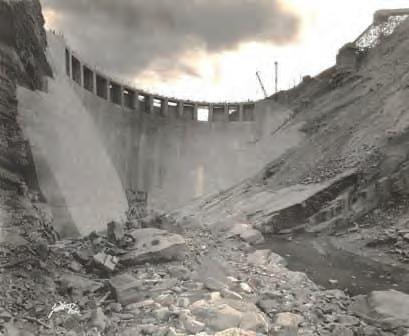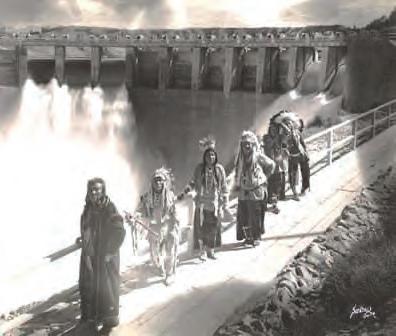
5 minute read
SKQ Dam history
and now Then



Seli’š Ksanka Qlispe’ Dam history shared
POLSON – The Seli’š Ksanka Qlispe’ Dam is an iconic sight. It rises more than 200 feet on the lower Flathead River, holding back aqua blue waters and framed by rolling grassy hills and the snow-capped Mission Mountains, but it’s much more than just a landmark.
The SKQ Dam supports recreation in Flathead Lake, prevents flooding around the region, generates electricity, and holds great cultural significance for the Confederated Salish and Kootenai Tribes. The dam is also the only one in the country owned solely by a Native American tribe.
- BRIAN LIPSCOMB, CEO OF ENERGY KEEPERS INC.

The hydroelectric dam sits six miles downriver from Flathead Lake. CSKT purchased the dam in 2015 and changed the dam’s name from Kerr Dam to Seli’š Ksanka Qlispe’ Dam soon after acquiring it. The dam is managed by the tribally owned business Energy Keepers Inc.
Normally, in the warmer months, Energy Keepers CEO Brian Lipscomb gives tours of the dam to local school groups. Visitors are welcome to view the dam from the overlook or walk to the river’s edge; however, the dam, overlook, and river access around it are closed to the public until further notice to protect dam staff from being exposed to COVID-19. Lipscomb said it’s especially important to keep employees safe because every dam is different, so the staff at the SKQ dam have specialized knowledge. If they all get sick, no one else can fill in for them.
According to Lipscomb, CSKT purchased the dam because they wanted to make decisions regarding natural resources on the reservation. It’s also located at a culturally important site. The location where the dam sits today used to feature a waterfall.
Owning the dam allows CSKT to make decisions about the way they manage the water that runs through it. Before the dam was built, the waterline of Flathead Lake fluctuated naturally throughout the year and that created ecological phenomena like a ring of lush vegetation around the edges of the lake when it receded. When the dam was built, people began controlling the amount of water in the lake, based not on ecology but on when people needed electricity. They released a lot of water through the dam during the day, when

energy needs were high, but held it back at night, when people were asleep and using less electricity. This management style harmed some fish and animal habitat. Now, under CSKT’s management, water flows over the dam are kept fairly steady in an approach that supports fish and animal habitat. People can also use Flathead Lake for boating, fishing and swimming all summer, rather than having to adjust activity based on the amount of water in the lake.
The dam generates about one million megawatt-hours of electricity each year. That’s enough to supply electricity for about 100,000 homes for a year, but the electricity generated by the dam doesn’t only power homes; instead, Energy Keepers Inc. sells the electricity on the wholesale market. The company sells electricity to 14 industrial customers and a number of small utilities. The dam provides some energy in Great Falls and to a community near Red Lodge. Over the years, the dam has generated energy used across the West, even in Las Vegas and Arizona.
The dam also helps prevent flooding across the northwest by holding back water to ensure that communities downstream don’t get flooded.
Facility staff coordinate with the Army Corps of Engineers to manage water. Lipscomb explained that the tribes’ decision to purchase the dam is rooted in the first agreement members of CSKT made with the federal government. After Native people entered into the Hellgate Treaty with the federal government, CSKT had rights to all the natural resources on the reservation, including the Flathead River where the dam sits today, and the resources were intended to be used by the tribe, but it didn’t work out that way.
In 1908, the federal government fractured the reservation into pieces and allowed settlers to claim ownership of parcels of land that were not allotted to tribal members. This was
part of a long-term effort by the federal government to extinguish Native Americans and their culture. At the same time, the federal government built an irrigation project to provide irrigation for farmers’ crops. It was under this system of checkerboard reservation ownership that the federal government began building the dam. CSKT didn’t have any say in whether the dam would be built. The Montana Power Company, then owners of the dam, completed construction in 1938.
“The dam’s construction was imposed upon the tribes at a time in history when the policy perspective of the federal government was to do away with the tribes,” Lipscomb said.
In the midst of the dam’s construction, the federal government signed the Indian Reorganization Act into law. The IRA turned over governance to the tribes and encouraged them to instate tribal constitutions. CSKT was the first tribe to adopt a constitution and become a self-governing body. The tribe immediately began to buy back land and amass assets that, years later, would allow it to purchase the dam. According to Lipscomb, the dam is one facet of CSKT’s commitment to managing natural resources on the Flathead Reservation for future generations.
“It’s out of appreciation for what our elders have done for us,” he said. “The reservation is our base for perpetuating our culture.” Story by Mary Auld for the Valley Journal

Shop Local!

We have amazing local businesses. Please be safe when visiting and remember to shop local.
Check out our Facebook page and website for summer and fall events.
www.ronanchamber.com or www.facebook.com/ronanchamber
We would like to thank our gold member businesses!









